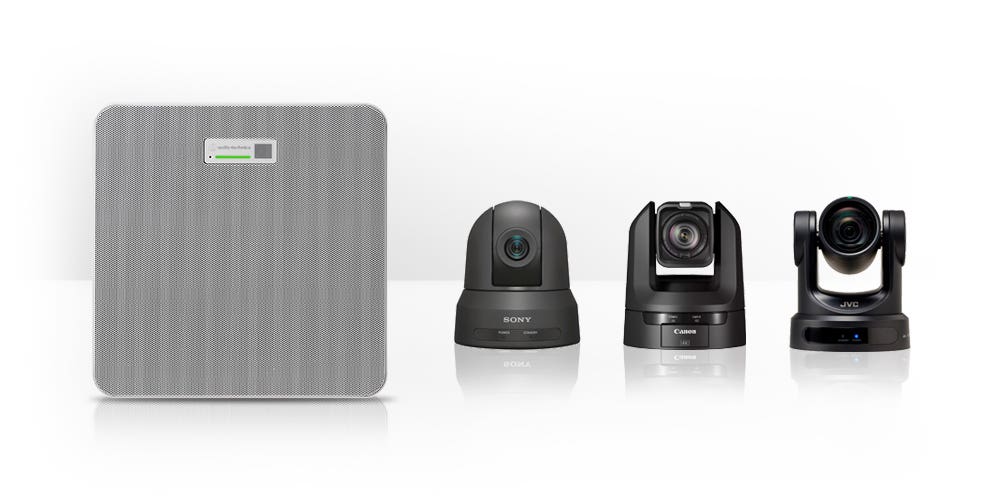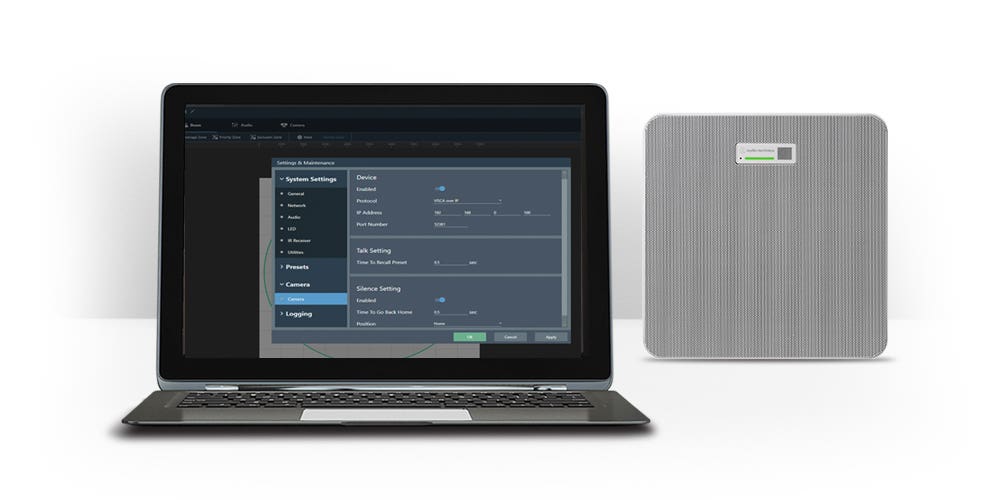The audiovisual industry has been flexible and innovative in adapting to the world’s changing communication and collaboration needs. Many manufacturers and experts have worked together to make life better for users by enabling technology interoperability. It also helps integrators by providing more options and making solutions easier to install and manage.
At Audio-Technica, we prioritize interoperability, and using VISCA over IP is one way we’re doing this. We started using VISCA over IP in our ATND1061DAN Beamforming Ceiling Array Microphone to simplify user and integration experiences.
You can use VISCA over IP (Video System Control Architecture over Internet Protocol) to control pan-tilt-zoom (PTZ) cameras and other video equipment over a network. Developed by Sony, VISCA lets you adjust the zoom, pan, tilt, focus, and other settings on video cameras.
Using VISCA over IP lets you control the camera settings over a network like Ethernet or internet connections.

How VISCA over IP Improves Collaboration Spaces
Remote camera control and management via the protocol is useful for broadcasting, live streaming, hybrid video conferencing, and security and surveillance applications. When you need professional audio in conference rooms or classrooms, the ATND1061DAN works perfectly with the VISCA over IP protocol. Using VISCA over IP, you can position the camera to match with the audio captured by the ATND1061. This will create a more natural experience in hybrid calls, which improves meeting equality.
In collaboration spaces like conference rooms and classrooms, VISCA over IP integrates with video conferencing software for better camera control. Users can easily set up and adjust camera settings with the intuitive interface.
Once the zones are set up, a presenter or instructor can walk between them and the camera will follow according to the presets. It’s also easy to duplicate settings for multiple classrooms that are similarly configured.
There are other beamforming microphones that react to sounds and the environment, but the ATND1061DAN with VISCA over IP is a unique solution.
“The ceiling array microphone goes a step further,” explained Sam Intihar, Product Manager at Audio-Technica. “It can identify which person in the room is specifically speaking based on the position.”
This feature makes video calls feel more like in-room conversations, where attendees focus on the person speaking. This creates a better experience for students or collaborators on the far end of a class or meeting.
Why We Chose This Protocol for Interoperability
At Audio-Technica, we know we don't make all of the pieces of the audiovisual puzzle. We want our solutions to work well with others. Many PTZ camera manufacturers support the VISCA over IP protocol, so the ATND1061DAN works with cameras like the Sony SRG-X40UH, Canon CR-N300, JVC KY-PZ200, and JVC KY-PZ200N.

The microphone is able to talk directly to the camera and doesn’t require another program like traditional setups did. The ATND1061DAN is configured through the Digital Microphone Manager software to send preset recall information directly to the PTZ camera. The ceiling array detects the location of the person talking, outputs a control signal, and calls up a preset camera position. If no one talks for a predetermined length of time, the camera will move back to a room view or other default.
VISCA over IP makes camera control easier than analog control options because it provides:
- Remote accessibility
- Scalability
- Real-time adjustments
- Presets and automation
- Simple integration
- Cost-effectiveness
Integration is simple and doesn’t require additional equipment or complex programming. And the system is designed to work with the camera’s proprietary configuration software.

How to Set Up and Manage the Solution
The Digital Microphone Manager software from Audio-Technica makes it easy for end users or integrators to program presets. You can set up microphone placement, identify audio pickup zones, set room size and dimensions, and draw in camera areas to be trigger points. Then you link to the camera and enable VISCA over IP by entering the IP address of the camera.
You can establish settings like angle of view, how many seconds of silence you want before the camera returns to its default setting, to zoom in on individuals in the host seat, and how long to wait before turning to an individual who has started talking.
Working with Audio-Technica
At Audio-Technica, we develop audio solutions for every commercial application. If you’re interested in learning more about our portfolio of products, start your journey here.